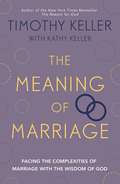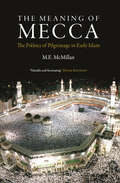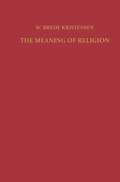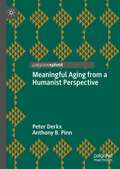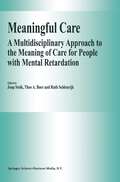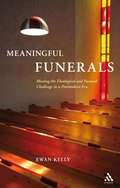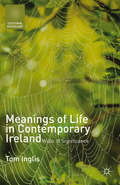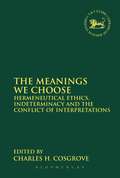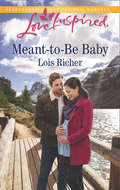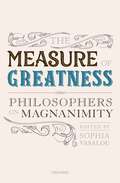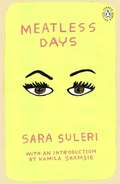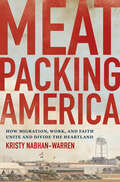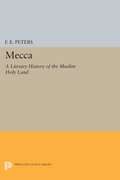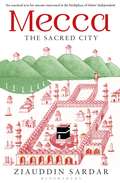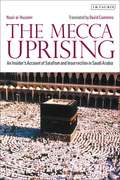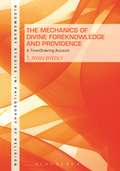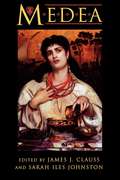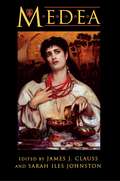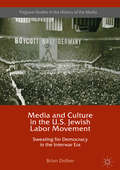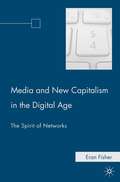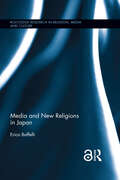- Table View
- List View
The Meaning of Marriage: Facing the Complexities of Marriage with the Wisdom of God
by Timothy KellerIn previous books respected New York pastor and bestselling author Timothy Keller has looked at such diverse and topical subjects as the existence of God, our need to do justice, the meaning of Jesus' life, and the human temptation to make idols - all through the twin lenses of a biblical framework and an engagement with contemporary culture.In this new book, co-authored with his wife, Kathy, he turns his attention to that most complex of matters: our need for love, and its expression in marriage. Beginning with the biblical narrative, and its pictures of marriage that span the original ideal to the broken to the redemptive, he looks at themes of friendship and commitment; the completion of men and women in each other; singleness, sex and divorce; and ministry and discipleship within the context of marriage. This is a profound and engaging work that will challenge and inspire people in all stages of life - single, newlywed and married.
The Meaning of Mecca: The Politi of Pilgrimage in Early Islam
by Ph.D. M E McMillanThe hajj, the fifth pillar of Islam, is a religious duty to be performed once in a lifetime by all Muslims who are able. The Prophet Muhammad set out the rituals of hajj when he led what became known as the Farewell Hajj in 10 AH / 632AD. This set the seal on Muhammad's career as the founder of a religion and the leader of a political entity based on that religion. The convergence of the Prophet with the politician infuses the hajj with political, as well as religious, significance. For the caliphs who led the Islamic community after Muhammad's death, leadership of the hajj became a position of enormous political relevance as it presented them with an unrivalled opportunity to proclaim their pious credentials and reinforce their political legitimacy. Exhaustively researched, The Meaning of Mecca is the first study to analyse the leadership of the hajj in the formative and medieval periods and to assess the political subtext of Islam's most high-profile religious ritual.
Meaningful Aging from a Humanist Perspective
by Peter Derkx Anthony B. PinnAging is a topic of growing interest. As life expectancy in western societies is increasing, the growing number and proportion of ‘elderly’ persons raise urgent questions on how to age ‘well’. Predominantly, questions on aging are taken from biomedical and economic paradigms, which are intertwined. While people of age are seen as a cost in society, biomedical research aims at curing the declining effects of aging, thus furthering ideals of ‘healthy’ aging, ‘active’ aging, or ‘successful’ aging. In this book, Peter Derkx offers a comprehensive account of meaningful aging with Anthony Pinn responding in a fruitful and constructive way, for the benefit and edification of all of us.
Meaningful Care: A Multidisciplinary Approach to the Meaning of Care for People with Mental Retardation
by RuthSeldenrijk Theo A.Boer JoopStolkIt is crucial for the quality of care of people with mental retardation that care providers experience their work as meaningful. A complexity, however, is the fact that this care is divided amongst a range of professions. This book addresses issues of meaning (meaning of care and meaning of life) from all the different professional perspectives involved. Such a multidisciplinary approach is unique and has never before been followed. The book contains the results of a series of interviews in which parents of people with mental retardation were asked what they conceive to be meaningful care. The results are placed in relation to experiences and conceptions of professional caregivers. Moreover, the study analyzes the cultural, philosophical, and theological significance of the concept, `meaningful care'. Finally, the book explores the relevance of this concept for practical professions such as medical care, social work, educational psychology, pedagogic counseling, and pastoral care. Scholarly depth is combined with experiential knowledge of professional practice. Hence, this book is an outstanding source of reflection for all those who work professionally with people with mental retardation.
Meaningful Funerals: Meeting the Theological and Pastoral Challenge in a Postmodern Era
by Ewan KellyThe majority of the British population no longer attend church and, consequently, lack familiarity with the Christian tradition, its stories, language and metaphors. However, when bereaved, many still turn to church representatives, working in parish settings or chaplaincies, to perform funerals for their loved ones. The key issue addressed in this book is how funerals may be created which are not only relevant for the bereaved, but also have theological integrity. A paradigm shift in the manner by which funerals are constructed is proposed - from imposing alien liturgies to creating a unique ritual which evolves from the meeting of the stories of the bereaved and that of the ritual leader. The argument for the co-construction of funerals is informed by contemporary models of grief and Kelly's own experience with bereaved parents who worked with hospital chaplains to co-construct funerals for their babies. Co-construction is a process which is centred on listening and empowering, and involves offering the bereaved choices from a range of ritual resources (sacred and secular) in order to help them shape their funeral's content. It is a model of ritual construction which requires time, availability and risk-taking on the part of the ritual leader but which significantly helps the spiritual needs of the bereaved to be met. Moreover, such a process facilitates sensitive regulation of grief in an age where its privatisation has meant the bereaved are often bereft of a means by which to benchmark their feelings, behaviour and decision making.
Meanings of Life in Contemporary Ireland: Webs of Significance (Cultural Sociology)
by T. InglisThe struggle to create and sustain meaning in our everyday lives is fought using cultural ingredients to spin the webs of meaning that keep us going. To help reveal the complexity and intricacy of the webs of meaning in which they are suspended, Tom Inglis interviewed one-hundred people in their native home of Ireland to discover what was most important and meaningful for them in their lives. Inglis believes language is a medium: there is never an exact correspondence between what is said and what is felt and understood. Using a variety of theoretical lenses developed within sociology and anthropology, Inglis places their lives within the context of Ireland's social and cultural transformations, and of longer-term processes of change such as increased globalisation, individualisation, and informalisation.
The Meanings We Choose: Hermeneutical Ethics, Indeterminacy and the Conflict of Interpretations (The Library of Hebrew Bible/Old Testament Studies)
by Charles H. CosgroveThe Meanings We Choose is an engagement with responsible bible reading-Hebrew Bible/Old Testament and New Testament texts-for the past as well as for the present and future. Its stated perspectives are multi-denominational Christian but the implications of such readings go far beyond a specific confessional framework. In the present political climate the aware, responsible "personal" is meaningful for any community, confessedly religious as well as otherwise. While the articles collected in this volume, broadly speaking, can and perhaps should be compartmentalized as ideological criticism, their significance for reading ideologies "different" from their own is more than considerable.
Meant-To-Be Baby: Her Cowboy Reunion Meant-to-be Baby A Father For Bella (Rocky Mountain Haven #1)
by Lois RicherA soldier or a father? Maybe he can be both in this Rocky Mountain Haven story
The Measure of Greatness: Philosophers on Magnanimity (Mind Association Occasional Series)
by Sophia VasalouMagnanimity is a virtue that has led many lives. Foregrounded early on by Plato as a philosophical virtue par excellence, it became one of the crown jewels in Aristotle's account of human excellence and was accorded equally salient place by other ancient thinkers. It is one of the most distinctive elements of the ancient tradition to filter into the medieval Islamic and Christian worlds. It sparked important intellectual engagements and went on to carve deep tracks through several of the later philosophies to inherit from this tradition. Under changing names and reworked forms, it would continue to breathe in the thought of Descartes and Hume, Kant, and Nietzsche. Its many lives have been joined by important continuities, yet they have also been fragmented by discontinuities — discontinuities reflecting larger shifts in ethical perspectives and competing answers to questions about the nature of the good life, the moral nature of human beings, and their relationship to the social and natural world they inhabit. They have also been punctuated by moments of intense controversy in which the vision of human greatness has itself been called into doubt. The aim of this volume is to provide an insight into the complex trajectory of a virtue whose glitter has at times been as dazzling as it has been divisive. By exploring the many lives it has lived, we will be in a better position to evaluate whether this is a virtue we still want to make central to our own ethical lives, and why.
The Measure of Greatness: Philosophers on Magnanimity (Mind Association Occasional Series)
Magnanimity is a virtue that has led many lives. Foregrounded early on by Plato as a philosophical virtue par excellence, it became one of the crown jewels in Aristotle's account of human excellence and was accorded equally salient place by other ancient thinkers. It is one of the most distinctive elements of the ancient tradition to filter into the medieval Islamic and Christian worlds. It sparked important intellectual engagements and went on to carve deep tracks through several of the later philosophies to inherit from this tradition. Under changing names and reworked forms, it would continue to breathe in the thought of Descartes and Hume, Kant, and Nietzsche. Its many lives have been joined by important continuities, yet they have also been fragmented by discontinuities — discontinuities reflecting larger shifts in ethical perspectives and competing answers to questions about the nature of the good life, the moral nature of human beings, and their relationship to the social and natural world they inhabit. They have also been punctuated by moments of intense controversy in which the vision of human greatness has itself been called into doubt. The aim of this volume is to provide an insight into the complex trajectory of a virtue whose glitter has at times been as dazzling as it has been divisive. By exploring the many lives it has lived, we will be in a better position to evaluate whether this is a virtue we still want to make central to our own ethical lives, and why.
Meatless Days: Introduction by the winner of the 2018 Women's Prize for Fiction Kamila Shamsie (Flamingo Ser.)
by Sara Suleri'Some of the more heart-shaking writing about love and grief I've ever read' Kamila Shamsie, from the introductionMeatless Days is a searing memoir of life in the newly-created country of Pakistan. When sudden and shocking tragedies hit the author's family two years apart, her personal crisis spirals into a wider meditation on universal questions: about being a woman when you're too busy being a mother or a sister or a wife to consider your own womanhood; about how it feels to begin life in a new language; about how our lives are changed by the people that leave them. This is a heart-breaking, hopeful and profound book that will get under your skin.'Extraordinary... as an evocation of family love, with all its sharpness, pain and need, Meatless Days is almost faultless' New Statesman
Meatpacking America: How Migration, Work, and Faith Unite and Divide the Heartland
by Kristy Nabhan-WarrenWhether valorized as the heartland or derided as flyover country, the Midwest became instantly notorious when COVID-19 infections skyrocketed among workers in meatpacking plants—and Americans feared for their meat supply. But the Midwest is not simply the place where animals are fed corn and then butchered. Native midwesterner Kristy Nabhan-Warren spent years interviewing Iowans who work in the meatpacking industry, both native-born residents and recent migrants from Latin America, Africa, and Asia. In Meatpacking America, she digs deep below the stereotype and reveals the grit and grace of a heartland that is a major global hub of migration and food production—and also, it turns out, of religion. Across the flatlands, Protestants, Catholics, and Muslims share space every day as worshippers, employees, and employers. On the bloody floors of meatpacking plants, in bustling places of worship, and in modest family homes, longtime and newly arrived Iowans spoke to Nabhan-Warren about their passion for religious faith and desire to work hard for their families. Their stories expose how faith-based aspirations for mutual understanding blend uneasily with rampant economic exploitation and racial biases. Still, these new and old midwesterners say that a mutual language of faith and morals brings them together more than any of them would have ever expected.
Mecca: A Literary History of the Muslim Holy Land
by F. E. PetersFor the non-Muslim, Mecca is the most forbidden of Holy Cities--and yet, in many ways it is the best known. Muslim historians and geographers have studied it, and countless pilgrims and travelers--many of them European Christians in disguise--have left behind lively and well-publicized accounts of life in Mecca and its associated shrine-city of Medina, where the Prophet lies buried. The stories of all these figures, holy men and heathens alike, come together in this book to offer a remarkably revealing literary portrait of the city's traditions and urban life and of the surrounding area. Closely following the publication of F. E. Peters's The Hajj (Princeton, 1994), which describes the perilous pilgrimage itself from the travelers' perspectives, this collection of writings and commentary completes the historical travelogue. The accounts begin with the Muslims themselves, in the patriarchal age of Abraham and Ishmael, and trace the sometimes glorious and sometimes sad history of Islam's central shrine down to the last Grand Sharif of Mecca, Husayn ibn Ali, whose fragile kingdom was overtaken by the House of Sa`ud in 1926. Because of chronic flooding and constant rebuilding, there is little or no material evidence for the early history of Islam's holy cities. By assembling, analyzing, and fashioning these literary accounts of Mecca, however, Peters supplies us with a vivid sense of place and human interaction, much as he did in his widely acclaimed Jerusalem (Princeton, 1985).Originally published in 1994.The Princeton Legacy Library uses the latest print-on-demand technology to again make available previously out-of-print books from the distinguished backlist of Princeton University Press. These editions preserve the original texts of these important books while presenting them in durable paperback and hardcover editions. The goal of the Princeton Legacy Library is to vastly increase access to the rich scholarly heritage found in the thousands of books published by Princeton University Press since its founding in 1905.
Mecca: The Sacred City
by Ziauddin SardarMecca is the heart of Islam. It is the birthplace of Muhammad, the direction towards which Muslims turn when they pray and the site of pilgrimage which annually draws some three million Muslims from all corners of the world. Yet Mecca's importance goes beyond religion. What happens in Mecca and how Muslims think about the political and cultural history of Mecca has had and continues to have a profound influence on world events to this day. In this captivating book, Ziauddin Sardar unravels the significance of Mecca. Tracing its history, from its origins as a 'barren valley' in the desert to its evolution as a trading town and sudden emergence as the religious centre of a world empire, Sardar examines the religious struggles and rebellions in Mecca that have powerfully shaped Muslim culture. Interweaving stories of his own pilgrimages to Mecca with those of others, Sardar offers a unique insight into not just the spiritual aspects of Mecca – the passion, ecstasy and longing it evokes – but also the conflict between heritage and modernity that has characterised its history. He unpeels the physical, social and cultural dimensions that have helped transform the city and also, though accounts of such Orientalist travellers as Richard Burton and Charles Doughty, the strange fascination that Mecca has long inspired in the Western imagination. And, ultimately, he explores what this tension could mean for Mecca's future. An illuminative, lyrical and witty blend of history, reportage and memoir, this outstanding book reflects all that is profound, enlightening and curious about one of the most important religious sites in the world.
The Mecca Uprising: An Insider's Account of Salafism and Insurrection in Saudi Arabia
by Nasir al-HuzaimiOn 20th November 1979, the Salafi Group, led by a charismatic figure named Juhaiman al-Utaibi, seized control of the Sacred Mosque in Mecca, the holiest site in the Muslim World. The Salafi Group was not trying to establish an Islamic state. Instead, its members believed they were players in a prophetic script about the End of Time. After a two-week siege, the Saudi government recaptured the mosque, threw the survivors into prison, and had them publicly executed. The Mecca Uprising offers an insider's account of the religious subculture that incubated the Mecca Uprising, written by a former member of the Salafi Group, Nasir al-Huzaimi. Huzaimi did not participate in the uprising, but he was arrested in a government sweep of Salafi Group members and spent six years in prison. In 2011, he published his memoir, Days with Juhaiman, offering the most detailed picture we have of the Salafi Group and Juhaiman. The Mecca Uprising had profound effects on Saudi Arabia and the Muslim world[DC1] [YG2] . The Saudi government headed off opposition from religious activists and made efforts to buttress the ruling family's legitimacy as the guardians of Islam. Huzaimi's memoir sheds light on the background of this religious and political landscape, and is the most detailed account we have of the Salafi Group and Juhaiman. The English edition is complete with an introduction and annotations prepared by expert David Commins to help readers understand the relevance of the Meccan Uprising [DC3] and how it fits into the history of the Islamic World. [DC1]lower case? Muslim world [YG2]changed to author's suggestion [DC3]Mecca Uprising
The Mecca Uprising: An Insider's Account of Salafism and Insurrection in Saudi Arabia
by Nasir al-HuzaimiOn 20th November 1979, the Salafi Group, led by a charismatic figure named Juhaiman al-Utaibi, seized control of the Sacred Mosque in Mecca, the holiest site in the Muslim World. The Salafi Group was not trying to establish an Islamic state. Instead, its members believed they were players in a prophetic script about the End of Time. After a two-week siege, the Saudi government recaptured the mosque, threw the survivors into prison, and had them publicly executed. The Mecca Uprising offers an insider's account of the religious subculture that incubated the Mecca Uprising, written by a former member of the Salafi Group, Nasir al-Huzaimi. Huzaimi did not participate in the uprising, but he was arrested in a government sweep of Salafi Group members and spent six years in prison. In 2011, he published his memoir, Days with Juhaiman, offering the most detailed picture we have of the Salafi Group and Juhaiman. The Mecca Uprising had profound effects on Saudi Arabia and the Muslim world[DC1] [YG2] . The Saudi government headed off opposition from religious activists and made efforts to buttress the ruling family's legitimacy as the guardians of Islam. Huzaimi's memoir sheds light on the background of this religious and political landscape, and is the most detailed account we have of the Salafi Group and Juhaiman. The English edition is complete with an introduction and annotations prepared by expert David Commins to help readers understand the relevance of the Meccan Uprising [DC3] and how it fits into the history of the Islamic World. [DC1]lower case? Muslim world [YG2]changed to author's suggestion [DC3]Mecca Uprising
The Mechanics of Divine Foreknowledge and Providence: A Time-Ordering Account (Bloomsbury Studies in Philosophy of Religion)
by T. Ryan ByerlyHow exactly could God achieve infallible foreknowledge of every future event, including the free actions of human persons? How could God exercise careful providence over these same events? Byerly offers a novel response to these important questions by contending that God exercises providence and achieves foreknowledge by ordering the times.The first part of the book defends the importance of the above questions. After characterizing the contemporary freedom-foreknowledge debate, Byerly argues that it has focused too narrowly on a certain argument for theological fatalism, which attempts to show that the existence of infallible divine foreknowledge poses a unique threat to the existence of creaturely libertarian freedom. Byerly contends, however, that bare existence of infallible divine foreknowledge cannot threaten freedom in this way; at most, the mechanics whereby this foreknowledge is achieved might so threaten human freedom.In the second part of the book, Byerly develops a model for understanding the mechanics whereby infallible foreknowledge is achieved that would not threaten creaturely libertarian freedom. According to the model, God infallibly foreknows every future event because God has placed the times that constitute the history of the world in primitive earlier-than relations to one another. After defending the consistency of this model of the mechanics of divine foreknowledge with creaturely libertarian freedom, the author applies it to divine providence more generally. A novel defense of concurrentism is the result.
The Mechanics of Divine Foreknowledge and Providence: A Time-Ordering Account (Bloomsbury Studies in Philosophy of Religion)
by T. Ryan ByerlyHow exactly could God achieve infallible foreknowledge of every future event, including the free actions of human persons? How could God exercise careful providence over these same events? Byerly offers a novel response to these important questions by contending that God exercises providence and achieves foreknowledge by ordering the times.The first part of the book defends the importance of the above questions. After characterizing the contemporary freedom-foreknowledge debate, Byerly argues that it has focused too narrowly on a certain argument for theological fatalism, which attempts to show that the existence of infallible divine foreknowledge poses a unique threat to the existence of creaturely libertarian freedom. Byerly contends, however, that bare existence of infallible divine foreknowledge cannot threaten freedom in this way; at most, the mechanics whereby this foreknowledge is achieved might so threaten human freedom.In the second part of the book, Byerly develops a model for understanding the mechanics whereby infallible foreknowledge is achieved that would not threaten creaturely libertarian freedom. According to the model, God infallibly foreknows every future event because God has placed the times that constitute the history of the world in primitive earlier-than relations to one another. After defending the consistency of this model of the mechanics of divine foreknowledge with creaturely libertarian freedom, the author applies it to divine providence more generally. A novel defense of concurrentism is the result.
Medea: Essays on Medea in Myth, Literature, Philosophy, and Art
by James J. Clauss Sarah Iles JohnstonFrom the dawn of European literature, the figure of Medea--best known as the helpmate of Jason and murderer of her own children--has inspired artists in all fields throughout all centuries. Euripides, Seneca, Corneille, Delacroix, Anouilh, Pasolini, Maria Callas, Martha Graham, Samuel Barber, and Diana Rigg are among the many who have given Medea life on stage, film, and canvas, through music and dance, from ancient Greek drama to Broadway. In seeking to understand the powerful hold Medea has had on our imaginations for nearly three millennia, a group of renowned scholars here examines the major representations of Medea in myth, art, and ancient and contemporary literature, as well as the philosophical, psychological, and cultural questions these portrayals raise. The result is a comprehensive and nuanced look at one of the most captivating mythic figures of all time. Unlike most mythic figures, whose attributes remain constant throughout mythology, Medea is continually changing in the wide variety of stories that circulated during antiquity. She appears as enchantress, helper-maiden, infanticide, fratricide, kidnapper, founder of cities, and foreigner. Not only does Medea's checkered career illuminate the opposing concepts of self and other, it also suggests the disturbing possibility of otherness within self. In addition to the editors, the contributors include Fritz Graf, Nita Krevans, Jan Bremmer, Dolores M. O'Higgins, Deborah Boedeker, Carole E. Newlands, John M. Dillon, Martha C. Nussbaum, Christiane Sourvinou-Inwood, and Marianne McDonald.
Medea: Essays on Medea in Myth, Literature, Philosophy, and Art
by Sarah Iles Johnston James J. ClaussFrom the dawn of European literature, the figure of Medea--best known as the helpmate of Jason and murderer of her own children--has inspired artists in all fields throughout all centuries. Euripides, Seneca, Corneille, Delacroix, Anouilh, Pasolini, Maria Callas, Martha Graham, Samuel Barber, and Diana Rigg are among the many who have given Medea life on stage, film, and canvas, through music and dance, from ancient Greek drama to Broadway. In seeking to understand the powerful hold Medea has had on our imaginations for nearly three millennia, a group of renowned scholars here examines the major representations of Medea in myth, art, and ancient and contemporary literature, as well as the philosophical, psychological, and cultural questions these portrayals raise. The result is a comprehensive and nuanced look at one of the most captivating mythic figures of all time. Unlike most mythic figures, whose attributes remain constant throughout mythology, Medea is continually changing in the wide variety of stories that circulated during antiquity. She appears as enchantress, helper-maiden, infanticide, fratricide, kidnapper, founder of cities, and foreigner. Not only does Medea's checkered career illuminate the opposing concepts of self and other, it also suggests the disturbing possibility of otherness within self. In addition to the editors, the contributors include Fritz Graf, Nita Krevans, Jan Bremmer, Dolores M. O'Higgins, Deborah Boedeker, Carole E. Newlands, John M. Dillon, Martha C. Nussbaum, Christiane Sourvinou-Inwood, and Marianne McDonald.
Media and Culture in the U.S. Jewish Labor Movement: Sweating for Democracy in the Interwar Era
by Brian DolberThis book explores the Jewish Left’s innovative strategies in maintaining newspapers, radio stations, and educational activities during a moment of crisis in global democracy. In the wake of the First World War, as immigrant workers and radical organizations came under attack, leaders within largely Jewish unions and political parties determined to keep their tradition of social unionism alive. By adapting to an emerging media environment dependent on advertising, turn-of-the-century Yiddish socialism morphed into a new political identity compatible with American liberalism and an expanding consumer society. Through this process, the Jewish working class secured a place within the New Deal coalition they helped to produce. Using a wide array of archival sources, Brian Dolber demonstrates the importance of cultural activity in movement politics, and the need for thoughtful debate about how to structure alternative media in moments of political, economic, and technological change.
Media and Culture in the U.S. Jewish Labor Movement: Sweating for Democracy in the Interwar Era
by Brian DolberThis book explores the Jewish Left’s innovative strategies in maintaining newspapers, radio stations, and educational activities during a moment of crisis in global democracy. In the wake of the First World War, as immigrant workers and radical organizations came under attack, leaders within largely Jewish unions and political parties determined to keep their tradition of social unionism alive. By adapting to an emerging media environment dependent on advertising, turn-of-the-century Yiddish socialism morphed into a new political identity compatible with American liberalism and an expanding consumer society. Through this process, the Jewish working class secured a place within the New Deal coalition they helped to produce. Using a wide array of archival sources, Brian Dolber demonstrates the importance of cultural activity in movement politics, and the need for thoughtful debate about how to structure alternative media in moments of political, economic, and technological change.
Media and New Capitalism in the Digital Age: The Spirit of Networks
by E. FisherThis book explores the new terrain of network capitalism through the transformations of the discourse on technology. Rather than viewing such discourse as either a true or false reflection of reality, Fisher evaluates the ideological role that technology discourse plays in the legitimation of a new form of capitalism. Based on an extensive empirical analysis, the book argues that contemporary technology discourse at one and the same time promises more personal empowerment through network technology and legitimates a more privatized, flexible, and precarious economic constellations. Such discourse signals a new tradeoff in the political culture of capitalism, from a legitimation discourse which emphasizes the capacity of technology and technique to bring about social emancipation (through equality, stability, and security) to a legitimation discourse which focuses on the capacity of technology to bring about individual emancipation (through individual empowerment, authenticity, creativity, and cooperation). Contrary to the prevailing assumption that sees network technology as liberating from the rigidity and pitfalls of a stifling, Fordist capitalism, the book offers a theoretical framework which sees contemporary technology discourse as an ideology that legitimates the economic, social, and political arrangements of the new capitalism.
Media and New Religions in Japan (Routledge Research in Religion, Media and Culture)
by Erica BaffelliThe Open Access version of this book, available at www.taylorfrancis.com/books/9781135117849, has been made available under a Creative Commons Attribution-Non Commercial-No Derivative 4.0 license. Japanese "new religions" (shinshūkyō) have used various media forms for training, communicating with members, presenting their messages, reinforcing or protecting the image of the leader, and, potentially, attracting converts. In this book the complex and dual relationship between media and new religions is investigated by looking at the tensions groups face between the need for visibility and the risks of facing attacks and criticism through media. Indeed media and new technologies have been extensively used by religious groups not only to spread their messages and to try to reach a wider audience, but also to promote themselves as a highly modern and up-to-date form of religion appropriate for a modern technological age. In 1980s and early 1990s some movements, such as Agonshū , Kōfuku no Kagaku, and Aum Shinrikyō came into prominence especially via the use of media (initially publications, but also ritual broadcasts, advertising campaigns, and public media events). This created new modes of ritual engagement and new ways of interactions between leaders and members. The aim of this book is to develop and illustrate particular key issues in the wider new religions and media nexus by using specific movements as examples. In particular, the analysis of the interaction between media and new religions will focus primarily on three case studies predominantly during the first period of development of the groups.
